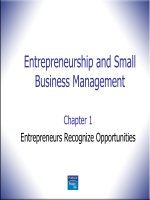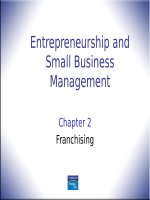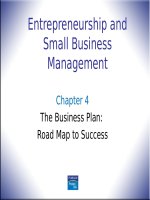Entrepreneurship and small business management chapter 12
Bạn đang xem bản rút gọn của tài liệu. Xem và tải ngay bản đầy đủ của tài liệu tại đây (226.99 KB, 17 trang )
Entrepreneurship and
Small Business
Management
Chapter 12
Understanding and Managing
Start-up, Fixed, and Variable
Costs
Ch. 12 Performance
Objectives
Identify the investment required
for business startup.
Describe the variable costs of
starting a business.
Analyze your fixed operating
costs and calculate gross profit.
Set up financial record keeping
for your business.
Entrepreneurship and Small Business
Management, 1/e
2
© 2012 Pearson Education, Upper Saddle River, NJ
07458.
Start-Up Investment
Seed capital is the
one-time expense of
starting a business.
Brainstorm every cost
to avoid surprises.
Consult advisors and
research industry
business plan models.
Include a cash
reserve for
emergencies.
Entrepreneurship and Small Business
Management, 1/e
3
© 2012 Pearson Education, Upper Saddle River, NJ
07458.
Predict the Payback Period
Start-up investment
= no. of
Net cash flow per mo.
months
This estimate tells investors how
long it will take your business to
bring in enough cash to cover the
start-up investment.
Entrepreneurship and Small Business
Management, 1/e
4
© 2012 Pearson Education, Upper Saddle River, NJ
07458.
Estimate Net Present
Value
NPV—technique used to determine the
current value of a proposed investment
Information used to calculate NPV:
Initial investment
Required rate of return (%)
Annual net cash flows
If NPV is a positive value, the
investment will have a positive return.
Entrepreneurship and Small Business
Management, 1/e
5
© 2012 Pearson Education, Upper Saddle River, NJ
07458.
Variable Costs
Change based on sales and production
Cost of goods sold (COGS) or Cost of
services sold (COSS)
Cost of materials
Cost of labor
Other variable costs
Sales commissions
Shipping and handling
Entrepreneurship and Small Business
Management, 1/e
6
© 2012 Pearson Education, Upper Saddle River, NJ
07458.
Finding the Contribution
Margin
Entrepreneurship and Small Business
Management, 1/e
7
© 2012 Pearson Education, Upper Saddle River, NJ
07458.
Average Contribution
Margin
A business selling a variety of products
can use an average COGS to determine
an average contribution margin.
Entrepreneurship and Small Business
Management, 1/e
8
© 2012 Pearson Education, Upper Saddle River, NJ
07458.
Fixed Operating Costs
Do not change based on sales/production
USAIDIR (common fixed operating costs)
Utilities (gas, electric, telephone, Internet)
Salaries (indirect labor)
Advertising
Insurance
Depreciation
Interest
Rent
Entrepreneurship and Small Business
Management, 1/e
9
© 2012 Pearson Education, Upper Saddle River, NJ
07458.
Depreciation Makes Records
More Accurate
If you buy a computer that will last
four years, spread the expense out
over four years.
Subtract 25% of the computer’s
cost from gross profit each year,
instead of subtracting 100% of the
cost from gross profit the first year.
Entrepreneurship and Small Business
Management, 1/e
10
© 2012 Pearson Education, Upper Saddle River, NJ
07458.
Fixed Operating Costs Can be
Dangerous to a Business
Fixed costs must be paid whether or
not your business has a gross profit.
Be careful about taking on additional
fixed costs.
Change fixed costs to variable costs
wherever possible.
Keep a cash reserve as a cushion of
protection in case of emergencies.
Entrepreneurship and Small Business
Management, 1/e
11
© 2012 Pearson Education, Upper Saddle River, NJ
07458.
Keeping Good Records
Accounting—tracking the inflows and
outflows of your business
Good records enable you to…
Create financial statements
Determine how to improve business
profits
Show investors the firm’s performance
Prove that payments have been made
Make audits go more smoothly
Entrepreneurship and Small Business
Management, 1/e
12
© 2012 Pearson Education, Upper Saddle River, NJ
07458.
Good Accounting Practices
Use computerized accounting
software.
Get a receipt for every purchase.
Create an invoice for every sale.
Backup computer records regularly.
Entrepreneurship and Small Business
Management, 1/e
13
© 2012 Pearson Education, Upper Saddle River, NJ
07458.
Good Accounting Practices
(continued)
Keep a copy of financial records in a
location away from the business
office.
Get a checking account for business
use only.
Use checks instead of cash to pay
business expenses.
Deposit money from sales right away.
Entrepreneurship and Small Business
Management, 1/e
14
© 2012 Pearson Education, Upper Saddle River, NJ
07458.
Cash Versus Accrual
Methods
Cash accounting—transactions
are recorded when cash is paid or
received
Accrual accounting—
transactions are recorded at the
time they occur, regardless of the
payment date
Entrepreneurship and Small Business
Management, 1/e
15
© 2012 Pearson Education, Upper Saddle River, NJ
07458.
Categories of Accounting Data
Variable costs—any costs that change
based on the number of units sold
Fixed costs—business expenses that must
be paid whether or not any sales are made
Capital equipment—money spent on
equipment expected to last a year or more
Investment—money invested in exchange
for part ownership (equity)
Entrepreneurship and Small Business
Management, 1/e
16
© 2012 Pearson Education, Upper Saddle River, NJ
07458.
Categories of Accounting
Data
(continued)
Loans—funds borrowed to start or
operate the business
Revenue—money received from sales
Inventory—items purchased for resale,
including suppliers’ shipping costs
Other costs—anything that does not
fit into the other expense categories
Entrepreneurship and Small Business
Management, 1/e
17
© 2012 Pearson Education, Upper Saddle River, NJ
07458.









